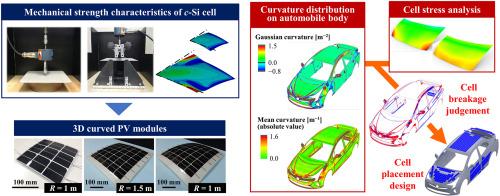Structural design and demonstration of three-dimensional curved photovoltaic modules using crystalline silicon solar cells
IF 6.3
2区 材料科学
Q2 ENERGY & FUELS
引用次数: 0
Abstract
The rapid deployment of photovoltaic (PV) devices through diversified applications is essential for advancing toward a zero-carbon society. The development of three-dimensional (3D) curved PV modules is crucial for new PV applications, such as vehicle-integrated PV systems. However, commonly used solar cell materials, particularly crystalline Si (c-Si), are inherently brittle and fragile. These characteristics present significant challenges for their integration onto 3D curved surfaces, thereby restricting the expansion of the PV coverage area. This study proposes a structural design methodology for 3D curved PV modules, incorporating flexural tests of solar cells, mechanical stress analysis across various cell sizes and radii of curvature (R), and evaluation of the risk of cell breakage when shaped to the targeted 3D curved geometries. Practical-scale 3D curved PV modules, featuring a 3-inch c-Si cell array with isotropic R values of 1 m or 1.5 m, have been successfully produced and characterized using electroluminescence and current–voltage characteristic measurements. The solar cell placement design has been implemented on an actual automobile body, identifying suitable surfaces for c-Si cell integration without the risk of breakage. The results demonstrate that reducing the cell size can enhance the total installed cell area on the automobile's body.

使用晶体硅太阳能电池的三维曲面光伏组件的结构设计和演示
通过多样化的应用快速部署光伏(PV)设备对于推动实现零碳社会至关重要。三维(3D)曲面光伏组件的开发对于新型光伏应用(如车载集成光伏系统)至关重要。然而,常用的太阳能电池材料,尤其是晶体硅(c-Si),本身易脆易碎。这些特性给将它们集成到三维曲面上带来了巨大挑战,从而限制了光伏覆盖面积的扩大。本研究提出了三维曲面光伏组件的结构设计方法,其中包括太阳能电池的弯曲测试、各种电池尺寸和曲率半径 (R) 的机械应力分析,以及在按照目标三维曲面几何形状成形时电池破损风险的评估。实际规模的三维曲面光伏组件采用了各向同性 R 值为 1 米或 1.5 米的 3 英寸晶体硅电池阵列,已成功制作完成,并利用电致发光和电流电压特性测量对其进行了表征。太阳能电池放置设计已在实际汽车车身上实施,确定了适合晶体硅电池集成的表面,且无破损风险。结果表明,减小电池尺寸可以增加车体上安装电池的总面积。
本文章由计算机程序翻译,如有差异,请以英文原文为准。
求助全文
约1分钟内获得全文
求助全文
来源期刊

Solar Energy Materials and Solar Cells
工程技术-材料科学:综合
CiteScore
12.60
自引率
11.60%
发文量
513
审稿时长
47 days
期刊介绍:
Solar Energy Materials & Solar Cells is intended as a vehicle for the dissemination of research results on materials science and technology related to photovoltaic, photothermal and photoelectrochemical solar energy conversion. Materials science is taken in the broadest possible sense and encompasses physics, chemistry, optics, materials fabrication and analysis for all types of materials.
 求助内容:
求助内容: 应助结果提醒方式:
应助结果提醒方式:


